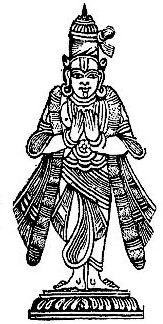Pey Alvar | |
|---|---|
 | |
| Personal | |
| Born | 4203 BCE (Traditional)[1][2] |
| Religion | Hinduism |
| Organization | |
| Philosophy | Vaishnava Bhakti |
| Religious career | |
| Literary works | Munram Tiruvantati |
| Honors | Alvar saint, regarded avatar of Nandaka |
Pey Alvar (also spelt Peyalvar, Peialvar, Pey Azhwar, or Pei Azhwar) is one of the twelve Alvar saints of South India, who are known for their affiliation to Vaishnava tradition of Hinduism. The verses of Alvars are compiled as Nalayira Divya Prabandham and the 108 temples revered are classified as Divya Desams. Pey Alvar is considered third in the list of the three principal Alvars, with the other two being Poigai Alvar and Bhoothath Alvar, collectively called Mutalamalvargal who are known to be born out of divinity. Pey Alvar composed hundred verses that are classified as Munram Tiruvantati and his composition is set in the antati style in which the ending syllable is the starting one for the next verse.
As per Hindu legend, Pey Alvar was found in the lily flower in the pond of the Adi Kesava Perumal Temple in Mylapore.[3] The site can be found in Arundale Street, Mylapore, Chennai. In Tamil, pey refers to one who is possessed and since the saint was madly attracted to Hindu god Vishnu, he got the name.
As per legend, the three Alvars were once were confined in a small dark enclosure during a rain in Thirukovilur and they experienced a fourth individual among them. They found out that it was god Vishnu and Poigai Alvar wished to see his face continuously but could view only from the simmering light of the lightning. With a view to maintain the continuity of light, Poigai instantly composed hundred songs wishing light to emerge. Pey Alvar and Bhoothath Alvar continued composing hundred songs each on Vishnu. The works of these earliest saints contributed to the philosophical and theological ideas of Vaishnavism. Along with the three Saiva Nayanmars, their works influenced the ruling Pallava kings of the South Indian region, resulting in changing the religious geography from Buddhism and Jainism to the two sects of Hinduism.
- ^ L. Annapoorna (2000). Music and temples, a ritualistic approach. p. 23. ISBN 9788175740907.
- ^ Sakkottai Krishnaswami Aiyangar (1911). Ancient India: Collected Essays on the Literary and Political History of Southern India. pp. 403–404. ISBN 9788120618503.
- ^ Ayyar, P. V. Jagadisa (1991). South Indian shrines: illustrated. New Delhi: Asian Educational Services. p. 539. ISBN 81-206-0151-3.